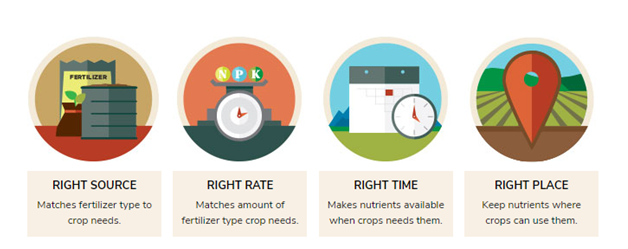Nitrogen Management and 4R Nutrient Stewardship
By: Corporate Communications
April 27, 2018
Sustainability
Share
Fertilizers play a significant role in securing the production of food crops around the world. It has been estimated that fertilizers currently support 40-60% of all crop production. Meeting future food security targets requires the responsible use of fertilizer nutrients.
Nitrogen (N) is the most frequently deficient nutrient in crop production. Plants rapidly become stressed when N supply is limited, resulting in a loss of crop yield and quality. Many N sources are available in supplying N to crops: organic N from animal manures and other waste products, N2 fixation by leguminous crops such as soybean, and inorganic N from commercial fertilizers.

Nitrogen management, however, is among the most complex and uncertain agronomic aspects of modern farming. Nitrogen fertilizer added to soil is susceptible to a variety of chemical and microbial transformations. The majority of applied nitrogen is usually uptake by crops, but some unrecovered N is incorporated into organic compound where it helps build soil organic matter and some N may move through soil into ground or surface waters. A small portion of the residual N can also be transformed into nitrous oxide gas and emitted to the atmosphere, which has undesirable greenhouse gas effects.
To better manage fertilizer, the fertilizer industry developed 4R nutrient stewardship (right fertilizer source, rate, time and placement) as a process to guide fertilizer Best Management Practices (BMP) in all regions of the world.
Right Source: The right source means matching the right N fertilizer product with soil properties and crop needs.
- Select N fertilizer sources that are less susceptible to loss by nitrate leaching or by volatilization.
- If broadcast urea, incorporate it into the soil shortly after spreading to minimize volatilization loess.
Right Rate: The right rate means matching N application rates with crop N requirement.
- Adjust N fertilizer application rates based on expected crop yield for each individual field and an appropriate soil test.
- Account for variable weather conditions before making decisions on fertilizer application rate.
- Adjusting N rate with technologies such as variable rate, and on the go sensors.
Right time: Making nitrogen’s availability synchronized with crop demand.
- Split time of application, slow and controlled release fertilizer technology, stabilizers and inhibitors.
- Understand the time of peak N demand by the plant and then apply fertilizer in advance of that time as closely as possible.
- Apply anhydrous ammonia when soil temperature low enough to inhibit microbial transformations (< 50˚F) and the soil will continue to cool.
Right place: Fertilizer should be applied to the soil surface and incorporated by rainfall, irrigation, or minimal tillage or it can be banded in concentrated zones beneath the surface to help maximize plant recovery.
- Place N fertilizer near the crop root zone or where it will move into the root zone, based on root development and architecture.
- Adjust N fertilizer application rates for field zones based on soil conditions and the potential productivity of the crop.
- Avoid broadcast applications of N fertilizer onto the soil surface if significant ammonia loss is possible before tillage, irrigation, or rainfall occurs; or where there is a risk of runoff (such as sloping land).
